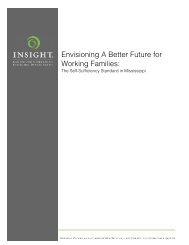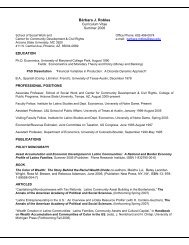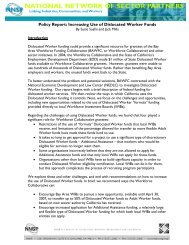Saving Patterns and Probability of Success in Individual ...
Saving Patterns and Probability of Success in Individual ...
Saving Patterns and Probability of Success in Individual ...
Create successful ePaper yourself
Turn your PDF publications into a flip-book with our unique Google optimized e-Paper software.
<strong>Sav<strong>in</strong>g</strong> <strong>Patterns</strong> <strong>and</strong> <strong>Probability</strong> <strong>of</strong> … 13<br />
Last but not least, the results from Table 4 suggest that, ceteris paribus, people with a higher<br />
deposit frequency have a higher probability <strong>of</strong> complet<strong>in</strong>g sav<strong>in</strong>gs. This f<strong>in</strong>d<strong>in</strong>g is significant.<br />
On the one h<strong>and</strong>, if we assume that effective case management helps establish a regular sav<strong>in</strong>g<br />
pattern for IDA savers, then it could be argued that by provid<strong>in</strong>g the proper structure, IDA<br />
programs will have a net positive impact on accumulation <strong>of</strong> sav<strong>in</strong>gs for low-<strong>in</strong>come households.<br />
On the other h<strong>and</strong>, controll<strong>in</strong>g for all other variables, if there is a positive association between<br />
sav<strong>in</strong>g regularity <strong>and</strong> the probability <strong>of</strong> complet<strong>in</strong>g sav<strong>in</strong>gs, then provid<strong>in</strong>g proper <strong>in</strong>centives to<br />
reward regularity, would help reduce attrition rates across IDA programs. The implications <strong>of</strong><br />
this result for program cost analysis <strong>and</strong> scale considerations could be the subject <strong>of</strong> a future<br />
study.<br />
S<strong>in</strong>ce <strong>in</strong> a logit model the estimated parameter values do not represent the marg<strong>in</strong>al impacts <strong>of</strong><br />
their respective variables, graphical techniques are utilized to show how changes <strong>in</strong> one variable<br />
can impact the overall probability <strong>of</strong> success while other variables <strong>in</strong> the model are held at their<br />
average levels, or any other constant level, for that matter. 14 In this respect, Figure 1 shows the<br />
relationship between probability <strong>of</strong> success <strong>in</strong> homeownership IDAs <strong>and</strong> deposits ratio for all<br />
active participants who stay <strong>in</strong> the program for 24 months while their amount <strong>of</strong> deposit per bank<br />
visit is measured at the average level for the entire sample. Simple <strong>in</strong>spection <strong>of</strong> the graph<br />
suggests that there is a 90% chance for participants to complete sav<strong>in</strong>gs <strong>in</strong> 24 months if they visit<br />
the bank (i.e., make a deposit) on average more than 2 times per quarter (or at a deposit ratio <strong>of</strong><br />
0.8). Similarly, there is an 80% chance <strong>of</strong> success for people who visit the bank only 7 times <strong>in</strong> a<br />
year. The implications <strong>of</strong> this relationship for a study <strong>of</strong> attrition rates are noteworthy. For<br />
example, <strong>in</strong> Table 3, the average deposit ratio for the UWGLA’s homeownership IDA program<br />
13














